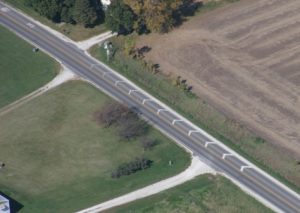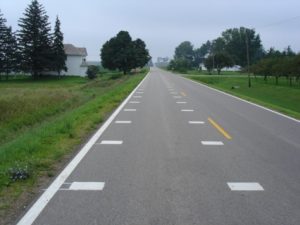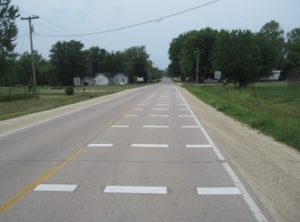Pavement Markings: Transverse Lane Markings
Transverse pavement markings usually consist of transverse bars or chevrons that are typically spaced to give drivers the perception that they are speeding up.

Transverse pavement markings usually consist of transverse bars or chevrons that are typically spaced to give drivers the perception that they are speeding up. This perception encourages drivers to be aware of their speeds and to slow down.
Transverse pavement markings are appropriate for rural traffic calming, especially in transition zones where drivers are being reminded of a change in roadway character.
Advantages
- Cost-effective
- Minimal impact to vehicle operations and emergency vehicles
- Minimal impact on drainage
Disadvantages
- Additional maintenance required to maintain, particularly with snow plows
- Less effective, particularly with adverse winter road conditions, when markings may not be visible
Effectiveness

A study in Minnesota used a converging chevron pattern in each travel lane as a traffic-calming measure (Corkle et al. 2001). Reductions of 5 and 3 miles per hour (mph) in mean speeds (depending on the lane) were observed and 7 and 5 mph in 85th percentile speeds. Also, a study using transverse pavement markings to slow traffic at a community entrance (Hallmark et al. 2007) found decreases of up to 2 mph in mean and 85th percentile speeds.
Cost
Transverse markings are low cost besides the initial cost to lay markings and the cost of subsequent maintenance.

References
Corkle, Jacqueline, Joni L. Giese, and Michael M. Marti. Investigating the Effectiveness of Traffic Calming Strategies on Driver Behavior, Traffic Flow, and Speed. Minnesota Local Road Research Board, Minnesota Department of Transportation, St. Paul, MN, 2001.
Hallmark, Shauna, Eric Peterson, Eric Fitzsimmons, Neal Hawkins, Jon Resler, and Tom Welch. Evaluation of Gateway and Low-Cost Traffic-Calming Treatments for Major Routes in Small Rural Communities. Center for Transportation Research and Education, Iowa State University, 2007.
